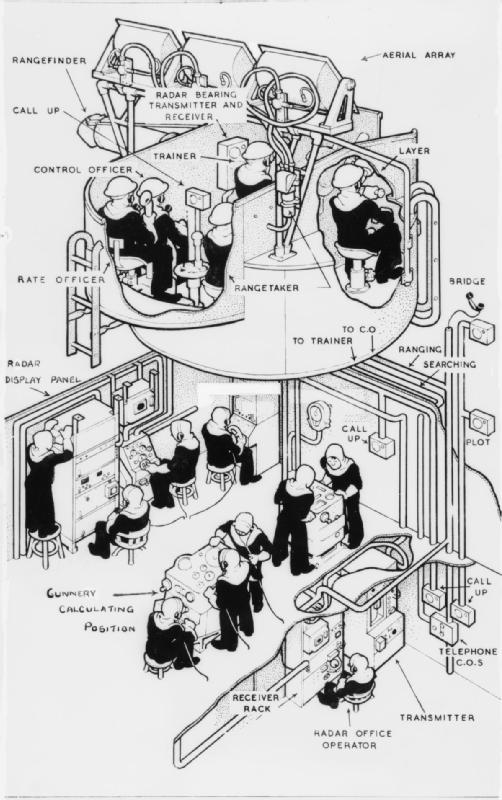Fuze Keeping Clock on:
[Wikipedia]
[Google]
[Amazon]
 The Fuze Keeping Clock (FKC) was a simplified version of the Royal Navy's
The Fuze Keeping Clock (FKC) was a simplified version of the Royal Navy's

''The Gunnery Pocket Book'', B.R. 224/45, 1945
* {{webarchive , url=https://web.archive.org/web/20110810225047/http://sydney.edu.au/engineering/it/research/tr/tr223.pdf , title= British Mechanical Gunnery Computers of World War II
Illustration of the FKC Mk II
Anti-aircraft artillery Military computers Naval artillery Artillery operation Equipment of the Royal Navy Fire-control computers of World War II Military equipment introduced in the 1930s
 The Fuze Keeping Clock (FKC) was a simplified version of the Royal Navy's
The Fuze Keeping Clock (FKC) was a simplified version of the Royal Navy's High Angle Control System
High Angle Control System (HACS) was a British anti-aircraft fire-control system employed by the Royal Navy from 1931 and used widely during World War II. HACS calculated the necessary Deflection (ballistics), deflection required to place an ex ...
analogue fire control computer. It first appeared as the FKC MkII in destroyer
In naval terminology, a destroyer is a fast, maneuverable, long-endurance warship intended to escort
larger vessels in a fleet, convoy, or carrier battle group and defend them against a wide range of general threats. They were conceived i ...
s of the 1938 ,''Tribal Class Destroyers'', Hodges, p. 27 while later variants were used on sloops, frigate
A frigate () is a type of warship. In different eras, the roles and capabilities of ships classified as frigates have varied.
The name frigate in the 17th to early 18th centuries was given to any full-rigged ship built for speed and maneuvera ...
s, destroyers, aircraft carrier
An aircraft carrier is a warship that serves as a seagoing airbase, equipped with a full-length flight deck and hangar facilities for supporting, arming, deploying and recovering carrier-based aircraft, shipborne aircraft. Typically it is the ...
s and several cruiser
A cruiser is a type of warship. Modern cruisers are generally the largest ships in a fleet after aircraft carriers and amphibious assault ships, and can usually perform several operational roles from search-and-destroy to ocean escort to sea ...
s. The FKC MkII was a non- tachymetric anti-aircraft fire control computer. It could accurately engage targets with a maximum speed of .
Operation
The FKC received vertical reference information from a ''Gyro Level Corrector'' and aircraft altitude, range, direction, and speed input information from the ''Rangefinder-Director'', and output to the guns the elevation and deflection data needed to hit the target, along with the correct fuze timing information, so that the shells fired would explode in the vicinity of the target aircraft. Most guns controlled by the FKC had ''Fuze Setting Pedestals'' or ''Fuze Setting Trays'' where the correct fuze timing was set on a clockwork mechanism within the AA shell warhead.
Development
Type 285 radar was an early addition to the FKC system, being fitted on new destroyers from mid-1941 onward, and retrofitted to existing destroyers as time and opportunity permitted. Later variants increased the maximum target speed to , and were combined with Gyro Rate Units (GRU) which gave tachometric capabilities to the system, andradar
Radar is a system that uses radio waves to determine the distance ('' ranging''), direction ( azimuth and elevation angles), and radial velocity of objects relative to the site. It is a radiodetermination method used to detect and track ...
which greatly improved ranging and rate keeping accuracy.Naval Weapons of WW2, Campbell
Wartime use
The FKC saw extensive use during the war onBritish Commonwealth
The Commonwealth of Nations, often referred to as the British Commonwealth or simply the Commonwealth, is an international association of 56 member states, the vast majority of which are former territories of the British Empire
The B ...
naval ships, typically on destroyers and sloops. Prior to the widespread use of radar, optical detection and ranging on high altitude aerial targets was a daunting task, as shown by 's Report of Proceedings, for 3 September 1940:
Occasionally conditions would conspire to favour the surface ships during an aerial attack, as again revealed by HMAS ''Parramatta''s Report of Proceedings, for 20 September 1940:
The FKC was used throughout the war and its effectiveness was increased by the use of radar for gunnery and to provide warning against surprise attack, as demonstrated by this account of bringing down a Japanese A6M Zero
The Mitsubishi A6M "Zero" is a long-range Carrier-based aircraft, carrier-capable fighter aircraft formerly manufactured by Mitsubishi Aircraft Company, a part of Mitsubishi Heavy Industries. It was operated by the Imperial Japanese Navy (IJN) ...
fighter aircraft (a "HAMP"), in 1944:
Notes
External links
''The Gunnery Pocket Book'', B.R. 224/45, 1945
* {{webarchive , url=https://web.archive.org/web/20110810225047/http://sydney.edu.au/engineering/it/research/tr/tr223.pdf , title= British Mechanical Gunnery Computers of World War II
Illustration of the FKC Mk II
Anti-aircraft artillery Military computers Naval artillery Artillery operation Equipment of the Royal Navy Fire-control computers of World War II Military equipment introduced in the 1930s